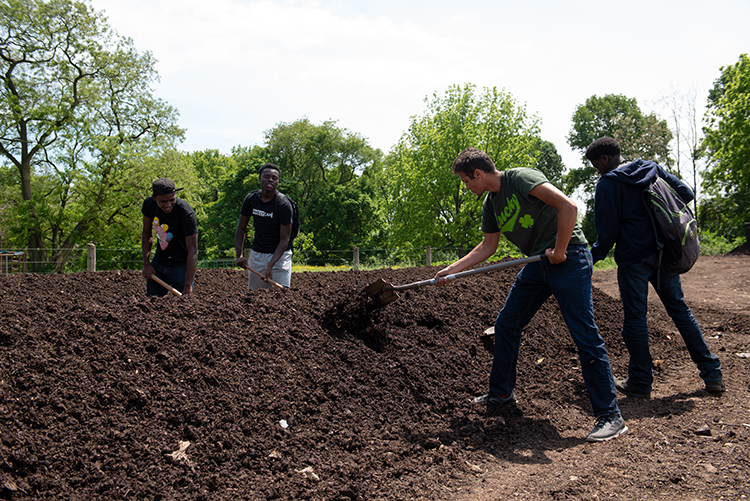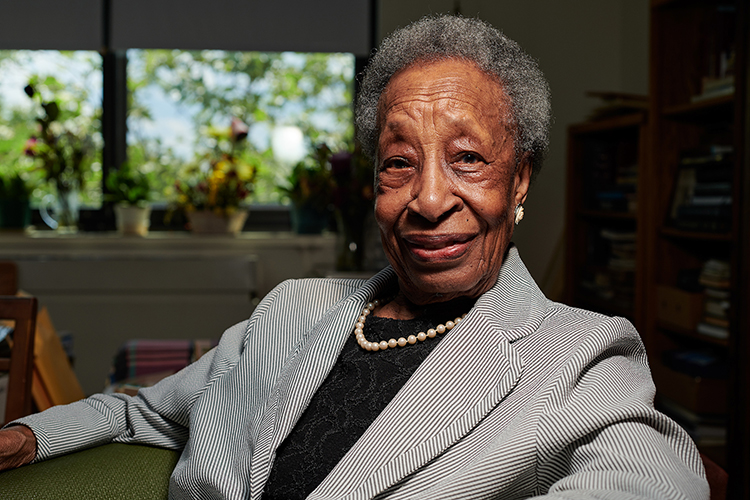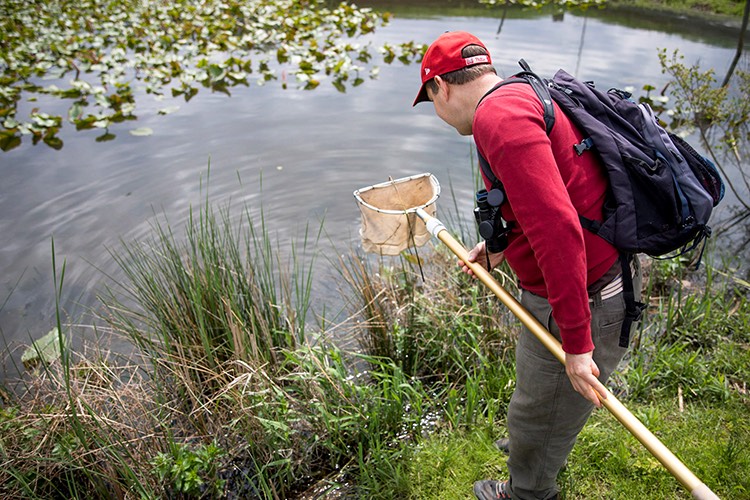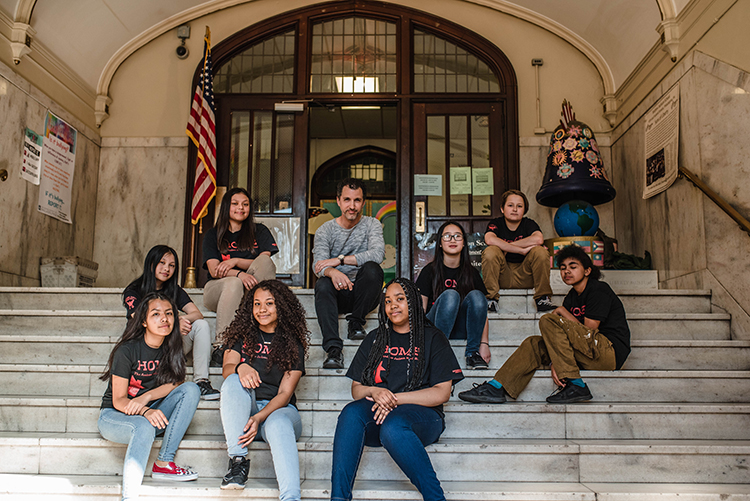Photo by Kriston Jae Bethel
By Alexandra Jones
On the two-acre Henry Got Crops urban farm at W.B. Saul High School in Roxborough, it’s easy to forget you’re still in the city. Lambs frolic near their mothers on green pastures while ruddy-colored cows placidly chew their cud. Salad greens grow green, purple, and red in tidy rows, destined to be harvested for the farm’s weekly stand and CSA program. Families relax at picnic tables under a cherry tree, enjoying ice cream sandwiches before picking up their produce.
At Saul, the School District of Philadelphia’s agricultural high school, students get to experience—and be a part of—the life cycles of plants and animals up close. But some of the most important activity occurring on its 140-acre campus is invisible to the human eye.
“This pile here was started about two months ago,” says Scott Blunk, gesturing toward a heap of dark earthlike matter taller than his truck. The retired Kansas-born agricultural salesman turned urban farm volunteer is driving through a series of windrows, long mounds of compost, in progress that he tends with the help of Saul students, staff and two large pieces of farm machinery.
Saul’s composting program began as a way to deal with the manure generated by the school’s livestock. Today, much more is broken down there. The long list includes animal waste from the Philadelphia Zoo; food scraps from three local composting companies and the three Weaver’s Way Co-op stores; coffee grounds from High Point Coffee; and excess spent grain from six different breweries, which is used to supplement feed for the school’s dairy cows. Clients pay a small fee for each dropoff.
“We’d got rid of all the headaches that the school had getting rid of all the poop,” Blunk says, “so we started looking into possible revenue streams to put money back into school, fund scholarship programs and hire kids to work.”
He points out the newest pile, with food scraps like watermelon rinds, banana peels and eggshells visible among the black soil. After six months of anaerobic activity, he’ll use the tractor and a compost turner to flip and aerate the tall piles into windrows, helping oxygen-loving microbes, insects, and other organisms finish the job. The nutrient-rich compost is sold through Weaver’s Way Co-op, which runs Henry Got Crops in collaboration with Saul, and distributed to community members,
households and gardens around the city.
While citywide school food-waste diversion and composting isn’t imminent, Henry Got Compost has made it possible for forward-thinking teachers, administrators, parents and students to show that it can be done, one school at a time.
While separating kitchen scraps to be processed into compost is common in sustainability-minded households and businesses in Philly, diverting food waste has a long way to go in schools.
In addition to the cost and effort involved in developing and enforcing systems for collection and disposal districtwide,
misconceptions around composting food waste—that it’s smelly, unsanitary or would attract pests—would make a top-down composting initiative challenging to implement, even though these issues wouldn’t exist in a well-run program.
“The primary barrier is that for a program to be successful it needs internal buy-in—it’s usually successful when you have a Green Team or leader in place [at a school],” says Emma Wu, the district’s sustainability project coordinator. “It wouldn’t be respectful for us as a district to implement a blanket program.”
The GreenFutures initiative—which also helps promote nutrition in schools and provides educational resources to help teachers incorporate environment, ecology and sustainability in curricula—has used this approach to establish recycling in Philadelphia schools. But the district is supportive of individual teachers, administrators and parent groups who want to implement food-waste diversion and composting on their own.
The Penn Alexander School in West Philly’s Spruce Hill is one of two schools in the district that regularly separates out food waste, trash and recycling during breakfast and three lunch periods, five days a week throughout the school year. (W.B. Saul is the other.)
It all started with Stephanie Kearney, who teaches middle school science and leads the robotics team at Penn Alexander, in 2015. To prepare for a waste-themed robotics competition, team members had to design a project that would solve a particular problem.
Her students chose to perform a waste audit: They sorted and weighed lunchroom trash, piling milk cartons and plastic containers together for recycling, pulling out plastic sporks, straws, chip bags, styrofoam lunchroom trays and other trash headed for the landfill, and set aside food waste.
The students found that one day’s three lunch periods generated 50 pounds of waste that could have been composted—150 pounds per day, 750 pounds in a five-day week, or 27,000 pounds a single school year, for just one elementary school with a little under 600 students.
Between April 2018 and March 2019, the district paid to have 34,592,798 pounds—more than 17,296 tons—of trash picked up and disposed of at 211 district schools, according to data provided by the district’s waste disposal company, J.P. Mascaro & Sons.
Mascaro also recycled 3,631,838 pounds, or 1,815 tons, of waste for city schools during that period, a diversion rate of a little more than 10 percent. (Philadelphia homes and businesses generate more than 1.5 million tons of waste annually with nearly 40 percent of that figure recycled, according to the zero-waste action plan.)
Penn Alexander tries to minimize what goes to the landfill. Thanks to a dedicated administration, a student body that’s now educated and enthusiastic about recycling and composting, school staff and support from the parent-run Home-School Association, they are succeeding. But keeping the waste stream clean takes education, work and resources.
First, robotics team members visited classrooms and made a video to teach their fellow students how to compost; they also used data from their waste audit to petition the district for a recycling dumpster. Bryn Mawr College donated a secondhand three-container waste disposal unit for the lunchroom that would allow students to sort trash, recycling, and food waste easily. A cafeteria staffer is tasked with supervising students while they dispose of their trash during all three lunch periods; he sorts out any misplaced sporks or ketchup packets that make their way into the food-waste container.
We have three fewer trash cans in the lunchroom now,” says interim principal Megan Wapner. “If the person who supervises composting is absent and the bins aren’t out, the kids will ask, ‘Where are the bins?’ They’ve definitely taken ownership over that, and they expect it, they want it.”
On-site composting is beyond Penn Alexan
der’s capabilities, so the school’s parent-run Home & School Association pays to have local company Bennett Compost make regular pickups, which are then processed at Saul. Each spring, Blunk delivers a load of compost for the students to use in the school’s garden plots and in classroom projects.
“The students shovel up the compost and put it in the beds, and we brought some inside to look at it under a microscope to see what was living in there,” Kearney says. “A lot of the kids don’t have exposure to that.”
The system runs smoothly, and Penn Alexander students are learning to become sustainable citizens and getting hands-on science lessons, too.
But there are still challenges to limiting food waste, says Wapner.
The district receives funding from the USDA to provide free or reduced-cost breakfast and lunch to every student, which means they’re bound to USDA guidelines for what students are served in those meals.
While the guidelines include food-waste reduction measures like offering students a choice between three fruit options so kids choose foods they want to eat, sometimes only one choice is available. And milk—which some students don’t drink—is the only beverage on the menu.
Although schools in the district offer share tables, where students can leave or swap out foods, those unopened items can’t be reused for the next day’s lunch. Regulations exist around donating these items to food pantries or shelters, so at nearly every Philly school, they go into the trash.
There’s also the problem of district-provided disposables. Wapner would like to see plastic packets for condiments replaced with refillable pumps. Pre-bagged utensil sets also generate unnecessary waste: a student who just needs a straw has to waste a spork, a napkin, and the plastic bag, too.
But the school district’s food services department has taken one big step in reducing waste in school lunchrooms: since late 2017, those polystyrene trays—an item that doesn’t break down in landfills and whose manufacture generates toxic byproducts—have been replaced with a tray made from 100 percent recycled paper.
Thanks to encouragement from stakeholders like Blunk and Wapner—and the opportunity to buy in bulk with school systems in cities like New York, Miami, Dallas and Orlando through the Urban School Food Alliance—PSD was able to purchase these compostable trays without blowing their budget.
“The actual tray is more expensive than styrofoam,” says Devon Sundberg, coordinator of dietetic services for the district, “but because we can cut out smaller bowls and portion dishes, it’s been cost neutral.”
Since the new trays are sturdier, the district sends around a quarter fewer disposables to the landfill—around 604,000 compostable trays per year versus 880,000 styrofoam trays, plates and bowls in the past.
Only Penn Alexander and Saul are composting their trays so far, and Blunk says that the district would need a commercial-scale composting solution if all schools participated. But the move represents a big step forward for the district, so that if—and hopefully, when—Philadelphia makes real strides toward a citywide composting program, they’ve already taken the first big step.
CORRRECTION: An earlier version of this story wrongly stated that Saul High School in Mt. Airy. It is in Roxborough.








Wonderful story!! Saul High School is in the Roxborough section of Philadelphia..
Saul is in the Roxborough section of Philadelphia. 🙂